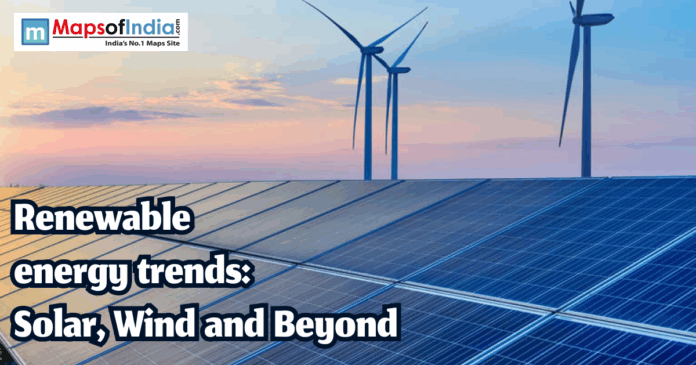The rise in the trend of renewable energy has made a massive shift as renewable energy technologies become central, addressing the problem of climate change and reducing dependence on fossil fuels as a source of energy. In many present renewable energy sources the solar and wind power sources have emerged as the leading sources that can help to create clean energy. The global transition in the energy scenario is not only about replacing old, known ways of energy creation, but at the same time, it is about building a sustainable and resilient future.
The Rise of Renewable Energy
To define what Renewable energy is, it is power generated from sources that are naturally renewable and never go extinct. These energy sources can be like sunlight, wind, water, and geothermal heat. These are different from energy sources like fossil fuels. These sources are abundant and sustainable. Over the past few decades, the known aspect of renewable energy has moved from being used as an alternative to becoming a main source of energy production. Different organizations on various levels, like Governments, corporations and individuals, are investing heavily to make these changes in energy generation more mainstream. The low cost needed for it, more developed technology, and supportive policies from the government have fueled the growth of this sector.
Why Solar Energy is Leading the Change
The Solar energy market has seen immense growth across the world. The cost of solar panels is getting so low that it has made it accessible to use in common households, businesses and industries, resulting in massive energy savings. The use of solar photovoltaic systems is usable to convert sunlight directly into electricity. Across the world, there are many solar farms that are supplying power to grids, while on many rooftops, solar panels are installed that provide individual energy independence. The versatile use of solar panels makes it appealing in both urban and rural areas for energy saving. Sunlight is free, and every country has abundant sunlight; and each country has made solar a central part of its renewable strategy.
Innovations in Solar Technology
There are many innovations happening in the scenario of solar energy. These technological advancements in these sources of energy are making solar energy more efficient and adaptable to everyone. The newly developed and massively used bifacial solar panels capture sunlight from both sides, which increases the energy output. Some places are using thin-film solar panels that are lightweight and flexible. This can be installed on surfaces like windows or vehicles, generating energy every time. In various countries where land is limited, they are developing solar farms on lakes and reservoirs. Integrating solar that has smart grids and storage solutions ensures that a stable supply of energy will continue to happen even during the cloudy days. These innovations show the continuous evolution of solar technology that is happening.
Wind Energy and Its Global Impact
Wind energy, at the same time, is becoming another dominant way of producing renewable energy. To produce energy from the flowing wind, the wind turbines move according to the wind and convert kinetic energy from the wind into electricity. Near the sea, wind farms have become a common way of producing energy in many countries where strong winds are flowing. The wind farms that are established offshore are gaining momentum as they harness stronger and more consistent winds at sea. With the use of wind energy, we can significantly reduce greenhouse gas emissions. This is also a good way of creating jobs in turbine manufacturing, installation, and maintenance.
Advances in Wind Technology
The innovation in wind technology is happening rapidly. The newly developed wind turbines are way taller and have larger blades, which allows them to capture more wind, generating more energy. The projects that are developed offshore are expanding with floating wind, in which turbines are designed to work in deep waters. Some countries are also focused on having hybrid systems that combine wind and solar to maximize the result of energy by producing power during different times of the day and year. Various digital tools, like artificial intelligence, are being used to predict wind patterns, and with that, they can optimize the performance of the blade. These innovations that have happened recently have made wind energy more reliable and cost-effective to produce by everyone.
The Role of Energy Storage
One of the biggest challenges faced by this way of generating energy is that this source of energy mostly depends on the present weather conditions. To address these issues, the way of energy storage is important. To address these issues, lithium-ion batteries have become central in balancing supply and demand. Many countries are developing large-scale storage systems that will allow them to store excess power during the peak production of energy and which can be used later. Scientists are developing next-generation batteries, which include solid-state and flow batteries, that promise to give even greater efficiency. The storage of energy ensures that renewable energy can be used to provide consistent and reliable power.
Environmental and Social Impact
The renewable energy sources play an important part in reducing carbon emissions and help to fight against climate change. These sources of energy are different from generating energy using fossil fuels. This way of energy production produces little or no air pollution. Using this way of producing energy can improve public health and lower medical costs that can be caused due to pollution. Using renewable sources of energy can bring electricity to remote areas, which can help to improve the quality of life. But at the same time, many challenges exist. The negative effects, such as land use to build solar farms or the impacts of wind farms, can negatively affect wildlife. Careful planning is necessary to balance environmental benefits and avoid potential drawbacks in future.
Final Thoughts
Renewable energy is a rapidly accepted way of energy generation and which is being accepted on a global level. There is immense potential available in solar and wind energy generation, while emerging sources expand various possibilities. With the rise of various technological innovations and the costs required being also less, the momentum to adapt this way of energy generation is strong. The global shift that is happening in renewables’ way of energy generation is not only about helping against climate change but is also useful for building resilient and sustainable societies. To capture its full potential, the path ahead requires innovation, investment, and cooperation. The way of renewable energy is widely being accepted across the world, making a way for a hopeful future where clean power becomes the foundation of human progress.





